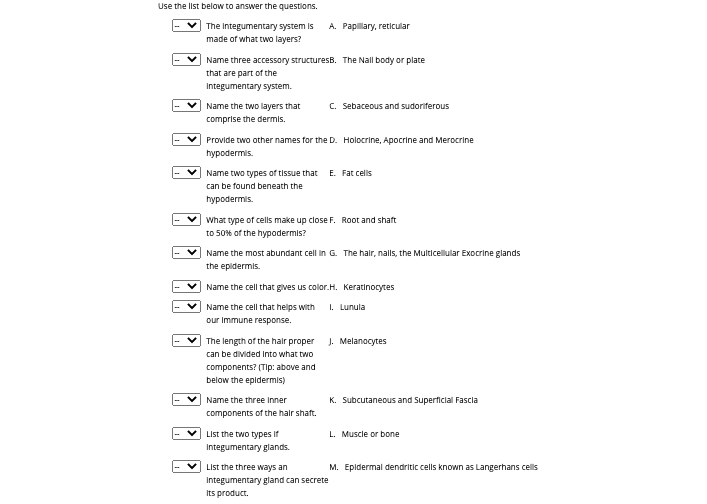Use the list below to answer the questions. The Integumentary system is A. Papilary, reticular made of what two layers? Name three accessory structuresB. The Nall body or plate that are part of the Integumentary system. Name the two layers that C. Sebaceous and sudoriferous comprise the dermis. Provide two other names for the D. Holocrine, Apocrine and Merocrine пуроdermis. Name two types of tissue that E. Fat cells can be found beneath the hypodermis. What type of cells make up close F. Root and shaft to 50% of the hypodermis? Name the most abundant cell in G. The hair, nalls, the Multicellular Exocrine glands the epidermis. Name the cell that gives us color.H. Keratinocytes Name the cell that helps with L. Lunula our Immune response. The length of the halr proper J. Melanocytes can be divided into what two components? (Tip: above and below the epidermis) Name the three inner K. Subcutaneous and Superficial Fascla components of the hair shaft. List the two types if L. Muscle or bone Integumentary glands. V List the three ways an M. Epidermal dendritic cells known as Langerhans cells Integumentary gland can secrete Its product.


The integumentary system refers to the body's organ system comprised of skin nails and hairs, and exocrine glands. This system helps in protecting the body from any microorganisms and chemicals as well as environmental factors.
The integumentary system is made up of epidermis and dermis layers.
The three structures that are part of theintegumentary system include hair, nails, and multicellular exocrine glands.
The two layers that comprise the dermis include the papillary dermis, and one is the reticular dermis.
The two other names for the hypodermis are subcutaneous tissue and superficial fascia.
The two issues that can be found beneath the hypodermis are muscle and bones.
The type of cell making up close to 50% of hypodermis is adipocytes called fat cells.
The most abundant cell in the epidermis is keratinocytes. They act as an immunomodulator.
The cells which are responsible for providing us the colors are melanocytes. They are composed of the pigment melanin, which determines the color.
The cells that help us with immune response epidermic dendritic cells, also called Langerhans cells are antigen-presenting cells.
The length of the hair proper can be divided into two components includes root and shaft.
The three inner components of hair shafts include a soft medulla (a central portion), a hard cortex, and a cuticle.
The two types of integumentary glands are sebaceous glands and sudoriferous glands. These are oil and sweat producing glands.
The three ways an integumentary gland can secrete its product are Holocrine, apocrine, and merocrine. These are exocrine glands.
The portion of nails is visible that covers the epidermis or the nail band is the nail plate and body.
The crescent-shaped whitish area of the plate cuticle of the fingernail is lunula.
The nail plate's anterior margin extends beyond the digit is called a free nail edge or margin
Step by step
Solved in 3 steps








